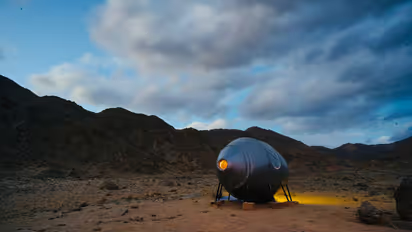ISRO launches India’s first analog space mission in Leh, aims to simulate extraterrestrial life

Synopsis
The Indian Space Research Organization (ISRO) on Friday announced the launch of its first analog space mission, to study the challenges of extraterrestrial conditions that will help in future space missions.
In a groundbreaking initiative, the Indian Space Research Organisation (ISRO) on Friday announced the launch of India's first analog space mission in Leh, to study the challenges of extraterrestrial conditions that will help in future space missions. This ambitious endeavor, initiated by ISRO’s Human Spaceflight Centre in collaboration with Aaka Space Studio, the University of Ladakh, IIT Bombay, and supported by the Ladakh Autonomous Hill Development Council, is set to explore the practicalities of life in an interplanetary habitat.
“This mission will simulate life in an interplanetary habitat to tackle the challenges of a base station beyond Earth,” ISRO stated, underscoring its commitment to extensive analogue research through partnerships with prominent academic groups.
The month-long project in Ladakh, conducted in partnership with ISRO and other academic giants, seeks to test and refine the capabilities required for human habitats in extreme extraterrestrial environments.
Sharing insights on the innovative design of the habitat, Aastha Jhala, founder of Aaka, said “The habitat prototype, developed by Aaka Space Studio, features advanced technologies including an EVA (extra-vehicular activity) preparation zone, circadian lighting systems, and hydroponics for food production. A stand-alone solar power system and comprehensive environmental monitoring ensure the habitat's self-sufficiency in extreme conditions.”
Guided by Jhala’s vision, the mission leverages the distinctive environmental characteristics of Ladakh to closely replicate Martian conditions. With its high altitude offering only 40% of sea-level oxygen and extreme temperatures fluctuating between 15°C and -10°C, the region mirrors the unforgiving climate astronauts might face on Mars or the Moon.
“This mission represents a crucial step in developing sustainable human habitats for space exploration,” Jhala added, emphasizing the mission's role in advancing the resilience and sustainability of space habitats.
Stay updated with the Breaking News Today and Latest News from across India and around the world. Get real-time updates, in-depth analysis, and comprehensive coverage of India News, World News, Indian Defence News, Kerala News, and Karnataka News. From politics to current affairs, follow every major story as it unfolds. Get real-time updates from IMD on major cities weather forecasts, including Rain alerts, Cyclone warnings, and temperature trends. Download the Asianet News Official App from the Android Play Store and iPhone App Store for accurate and timely news updates anytime, anywhere.